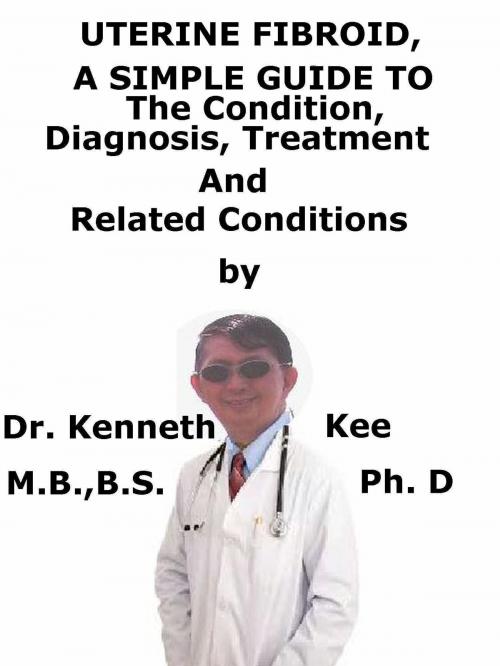Uterine Fibroid, A Simple Guide To The Condition, Diagnosis, Treatment And Related Conditions
Nonfiction, Health & Well Being, Medical, Specialties, Gynecology & Obstetrics, Health, Women&| Author: | Kenneth Kee | ISBN: | 9781370822584 |
| Publisher: | Kenneth Kee | Publication: | November 7, 2016 |
| Imprint: | Smashwords Edition | Language: | English |
| Author: | Kenneth Kee |
| ISBN: | 9781370822584 |
| Publisher: | Kenneth Kee |
| Publication: | November 7, 2016 |
| Imprint: | Smashwords Edition |
| Language: | English |
Uterine Fibroids are medical benign tumors (non-cancerous) of the smooth muscles of the uterine cavity.
They are the most frequent tumor found in women (25%) especially after the age of 35.
Uterine fibroids are tumors that grow in a woman's womb (uterus).
These growths are normally not cancerous (benign).
Fibroids are normally relatively avascular and may degenerate forming cysts and becoming calcified.
They are believed to be caused by:
1. Hormones in the body
2. Genes (may run in families)
50% of all women have fibroids by age 50.
Frequent symptoms are:
1. Heavy menstrual flow sometimes with blood clots
2. Irregular menstrual periods
3. Painful menses
4. Backache
5. Pain with exercise
6. Painful and frequent urination
Pelvic examination may show enlarged uterine swellings
Ultrasound scans showed presence of fibroids
Hysteroscopy uses a long, thin tube placed through the vagina and into the womb to examine the inside of the uterus
1. If small no treatment is required.
2. If larger, then treatment depends on the size, extent of the lesions, age of the patient and the desire for pregnancy.
3. Birth control pills to help control heavy periods
4. Intrauterine devices (IUDs) that secrete hormones to decrease the heavy bleeding and pain
5. Correction of anemia
Surgery is needed if larger:
Myomectomy. (removal of the fibroid and part of the lining of the uterine wall)
This surgery excises the benign fibroid tumors from the uterus.
The procedure is a good choice if the patient wants to have children.
It will not prevent fibroids from growing again.
Hysterectomy (removal of the whole uterus or womb)
This surgery removes the uterus completely.
It may be an option if the patient does not want children, medicines do not work, or the patient cannot have any other procedures.
TABLE OF CONTENT
Introduction
Chapter 1 Uterine Fibroid
Chapter 2 Causes
Chapter 3 Symptoms
Chapter 4 Diagnosis
Chapter 5 Treatment
Chapter 6 Prognosis
Chapter 7 Uterine Polyp
Chapter 8 Uterine Cancer
Epilogue
All women have fibroids some small some bigger.
In fact fibroid is very common especially before menopause.
The fibroid is believed to be thickened muscle tissue in the uterus or womb.
Most of the patients with fibroid do not show any symptoms but those with complications may have severe bleeding or pain.
Always send the patient with heavy menstrual bleeding for a comprehensive gynecological examination.
Uterine Fibroids are medical benign tumors (non-cancerous) of the smooth muscles of the uterine cavity.
They are the most frequent tumor found in women (25%) especially after the age of 35.
Uterine fibroids are tumors that grow in a woman's womb (uterus).
These growths are normally not cancerous (benign).
Fibroids are normally relatively avascular and may degenerate forming cysts and becoming calcified.
They are believed to be caused by:
1. Hormones in the body
2. Genes (may run in families)
50% of all women have fibroids by age 50.
Frequent symptoms are:
1. Heavy menstrual flow sometimes with blood clots
2. Irregular menstrual periods
3. Painful menses
4. Backache
5. Pain with exercise
6. Painful and frequent urination
Pelvic examination may show enlarged uterine swellings
Ultrasound scans showed presence of fibroids
Hysteroscopy uses a long, thin tube placed through the vagina and into the womb to examine the inside of the uterus
1. If small no treatment is required.
2. If larger, then treatment depends on the size, extent of the lesions, age of the patient and the desire for pregnancy.
3. Birth control pills to help control heavy periods
4. Intrauterine devices (IUDs) that secrete hormones to decrease the heavy bleeding and pain
5. Correction of anemia
Surgery is needed if larger:
Myomectomy. (removal of the fibroid and part of the lining of the uterine wall)
This surgery excises the benign fibroid tumors from the uterus.
The procedure is a good choice if the patient wants to have children.
It will not prevent fibroids from growing again.
Hysterectomy (removal of the whole uterus or womb)
This surgery removes the uterus completely.
It may be an option if the patient does not want children, medicines do not work, or the patient cannot have any other procedures.
TABLE OF CONTENT
Introduction
Chapter 1 Uterine Fibroid
Chapter 2 Causes
Chapter 3 Symptoms
Chapter 4 Diagnosis
Chapter 5 Treatment
Chapter 6 Prognosis
Chapter 7 Uterine Polyp
Chapter 8 Uterine Cancer
Epilogue
All women have fibroids some small some bigger.
In fact fibroid is very common especially before menopause.
The fibroid is believed to be thickened muscle tissue in the uterus or womb.
Most of the patients with fibroid do not show any symptoms but those with complications may have severe bleeding or pain.
Always send the patient with heavy menstrual bleeding for a comprehensive gynecological examination.















